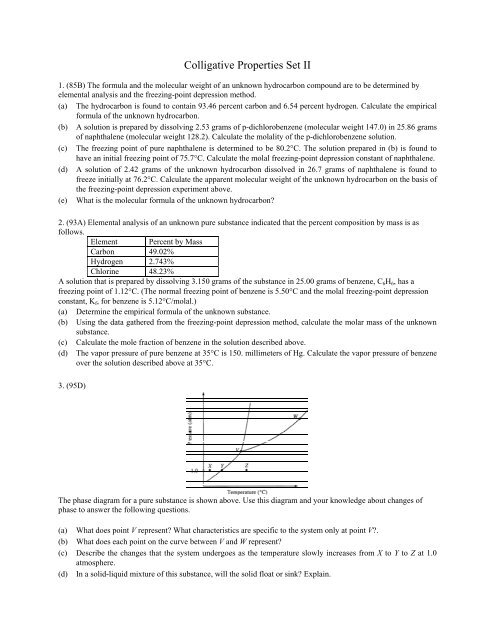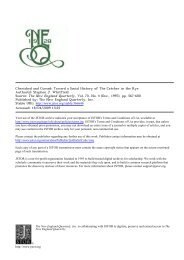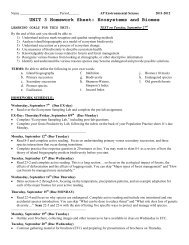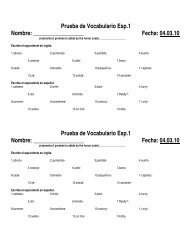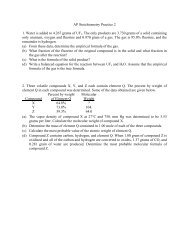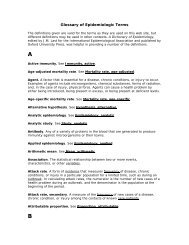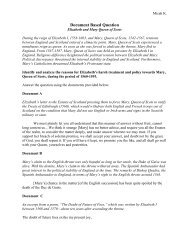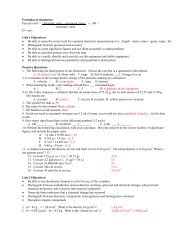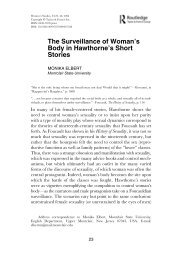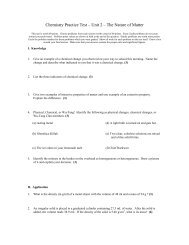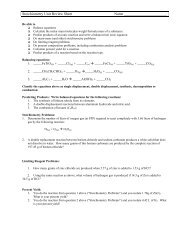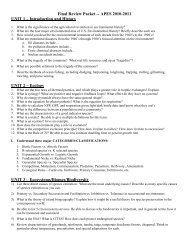Colligative Properties Set II
Colligative Properties Set II
Colligative Properties Set II
Create successful ePaper yourself
Turn your PDF publications into a flip-book with our unique Google optimized e-Paper software.
<strong>Colligative</strong> <strong>Properties</strong> <strong>Set</strong> <strong>II</strong><br />
1. (85B) The formula and the molecular weight of an unknown hydrocarbon compound are to be determined by<br />
elemental analysis and the freezing-point depression method.<br />
(a) The hydrocarbon is found to contain 93.46 percent carbon and 6.54 percent hydrogen. Calculate the empirical<br />
formula of the unknown hydrocarbon.<br />
(b) A solution is prepared by dissolving 2.53 grams of p-dichlorobenzene (molecular weight 147.0) in 25.86 grams<br />
of naphthalene (molecular weight 128.2). Calculate the molality of the p-dichlorobenzene solution.<br />
(c) The freezing point of pure naphthalene is determined to be 80.2°C. The solution prepared in (b) is found to<br />
have an initial freezing point of 75.7°C. Calculate the molal freezing-point depression constant of naphthalene.<br />
(d) A solution of 2.42 grams of the unknown hydrocarbon dissolved in 26.7 grams of naphthalene is found to<br />
freeze initially at 76.2°C. Calculate the apparent molecular weight of the unknown hydrocarbon on the basis of<br />
the freezing-point depression experiment above.<br />
(e) What is the molecular formula of the unknown hydrocarbon<br />
2. (93A) Elemental analysis of an unknown pure substance indicated that the percent composition by mass is as<br />
follows.<br />
Element Percent by Mass<br />
Carbon 49.02%<br />
Hydrogen 2.743%<br />
Chlorine 48.23%<br />
A solution that is prepared by dissolving 3.150 grams of the substance in 25.00 grams of benzene, C 6 H 6 , has a<br />
freezing point of 1.12°C. (The normal freezing point of benzene is 5.50°C and the molal freezing-point depression<br />
constant, K f , for benzene is 5.12°C/molal.)<br />
(a) Determine the empirical formula of the unknown substance.<br />
(b) Using the data gathered from the freezing-point depression method, calculate the molar mass of the unknown<br />
substance.<br />
(c) Calculate the mole fraction of benzene in the solution described above.<br />
(d) The vapor pressure of pure benzene at 35°C is 150. millimeters of Hg. Calculate the vapor pressure of benzene<br />
over the solution described above at 35°C.<br />
3. (95D)<br />
The phase diagram for a pure substance is shown above. Use this diagram and your knowledge about changes of<br />
phase to answer the following questions.<br />
(a) What does point V represent What characteristics are specific to the system only at point V.<br />
(b) What does each point on the curve between V and W represent<br />
(c) Describe the changes that the system undergoes as the temperature slowly increases from X to Y to Z at 1.0<br />
atmosphere.<br />
(d) In a solid-liquid mixture of this substance, will the solid float or sink Explain.
4. The normal boiling and freezing points of argon are 87.3 K and 84.0 K, respectively. The triple point is at 82.7 K<br />
and 0.68 atmosphere.<br />
(a) Use the data above to draw a phase diagram for argon. Label the axes and label the regions in which the solid,<br />
liquid and gas phases are stable. On the phase diagram, show the position of the normal boiling point.<br />
(b) Describe any changes that can be observed in a sample of solid argon when the temperature is increased from<br />
40 K to 160 K at a constant pressure of 0.50 atmosphere.<br />
(c) Describe any changes that can be observed in a sample of liquid argon when the pressure is reduced from 10<br />
atmospheres to 1 atmosphere at a constant temperature of 100 K, which is well below the critical temperature.<br />
(d) Does the liquid phase of argon have a density greater than, equal to, or less than the density of the solid phase<br />
Explain your answer, using information given in the introduction to this question.<br />
5. The molar mass of an unknown solid, which is nonvolatile and a nonelectrolyte, is to be determined by the<br />
freezing-point depression method. The pure solvent used in the experiment freezes at 10°C and has a known molal<br />
freezing-point depression constant, Kƒ. Assume that the following materials are also available.<br />
• test tubes • stirrer • pipet • stopwatch • graph paper<br />
• thermometer • balance • beaker • ice • hot-water bath<br />
(a) Using the two sets of axes provided below, sketch cooling curves for (i) the pure solvent and for (ii) the<br />
solution as each is cooled from 20°C to 0.0°C<br />
Pure Solvent<br />
Solution<br />
20<br />
20<br />
15<br />
15<br />
10<br />
10<br />
5<br />
5<br />
0<br />
0<br />
Time<br />
0<br />
0<br />
Time<br />
(b) Information from these graphs may be used to determine the molar mass of the unknown solid.<br />
(i) Describe the measurements that must be made to determine the molar mass of the unknown solid by this<br />
method.<br />
(ii) Show the setup(s) for the calculation(s) that must be performed to determine the molar mass of the<br />
unknown solid from the experimental data.<br />
(iii) Explain how the difference(s) between the two graphs in part (a) can be used to obtain information<br />
needed to calculate the molar mass of the unknown solid.<br />
(c) Suppose that during the experiment a significant but unknown amount of solvent evaporates from the test tube.<br />
What effect would this have on (he calculated value of the molar mass of the solid (i.e., too large, too small, or<br />
no effect) Justify your answer.<br />
(d) Show the setup for the calculation of the percentage error in a student’s result if the student obtains a value of<br />
126 g mol -1 for the molar mass of the solid when the actual value is 120. g mol -1 .
Answers:<br />
1. (a) Assume 100. g sample of the hydrocarbon<br />
93.46 g C х 1 mol C = 7 . 782 mol C<br />
12 .01 g C<br />
6 .54 g H х 1 mol H<br />
= 6 . 49 mol H<br />
1 . 008 g H<br />
7.782 mol C 1 . 20<br />
6.49 mol H = 1 . 00 ; C 1 . 20 H 1 . 00 = C 6 H 5<br />
2 .53 g х 1 mol<br />
mol s olute<br />
(b) m =<br />
1 . 0 kg solvent = 147.0 g<br />
= 0 .666 mola l<br />
0 . 02586 kg<br />
(c) ΔT f = (80.2 - 75.7)°C = 4.5°C<br />
k f = ΔT f /m = 4.5°C / 0.666 molal = 6.8°C/molal<br />
(d) ΔT f = (80.2 - 76.2)°C = 4.0°C<br />
1<br />
4 . 0 º C х 6 . 8 º C _ k g solvent 2 .43 g solute<br />
х<br />
1 mol s olute 0 .0267 kg solvent = 154 g/mol<br />
(e) C 6 H 5 = 77<br />
# empirical units/mol = 154/77 = 2<br />
molecular formula = (C 6 H 5 ) 2 = C 12 H 10<br />
2. (a) moles / 100 g C H Cl<br />
49.02/12.01 2.743/1.00848.23/35.45<br />
= 4.081 = 2.722 = 1.360<br />
mol ratio 3 2 1<br />
empirical formula: C 3 H 2 Cl<br />
(b) ΔT f = (K f )(m)<br />
4.38°= ( 5.12° molal ) × 3.150g molmass<br />
0.02500kg<br />
= 147 g mol<br />
25. 00 78. 11<br />
(c) mol fraction = mol benzene / total mol =<br />
3 . 150 25. 00<br />
= 0 . 938<br />
147<br />
+<br />
78. 11<br />
(d) vapor pressure = mol fraction × P o = (0.938)(150 mm) = 141 mm Hg<br />
3. (a) Triple point. All three states of the substance coexist (equilibrium); the solid and the liquid have identical<br />
vapor pressures.<br />
(b) Curve VW represents the equilibrium between the liquid and its vapor. Along this line the liquid will be<br />
boiling. The points represent the vapor pressure of the liquid as a function of temperature.<br />
(c) At point X the substance is a solid, as its temperature increases (at constant pressure), at point Y the solid is in<br />
equilibrium with its vapor and will sublime. From point Y to Z it exist only as a vapor.<br />
(d) Sink. A positive slope of the solid-liquid line indicates that the solid is denser than its liquid and, therefore,<br />
will sink.
2<br />
1.8<br />
1.6<br />
1.4<br />
1.2<br />
re (atm.) 1<br />
0.8<br />
0.6<br />
0.4<br />
Solid<br />
Ö<br />
Ö<br />
Liquid<br />
Gas<br />
Ö<br />
normal<br />
B.P.<br />
4. (a)<br />
(b) The argon sublimes.<br />
(c) The argon vaporizes.<br />
(d) The liquid phase is less dense than the solid<br />
phase. Since the freezing point of argon is higher<br />
than the triple point temperature, the solid-liquid<br />
equilibrium line slopes to the right with<br />
increasing pressure. Thus, if a sample of liquid<br />
argon is compressed (pressure increased) at<br />
constant temperature, the liquid becomes a solid.<br />
Because increasing pressure favors the denser<br />
phase, solid argon must be the denser phase.<br />
0.2<br />
0<br />
81 82 83 84 85 86 87 88 89<br />
Temperature (K)<br />
5. (a)<br />
pure solvent<br />
solution<br />
20<br />
20<br />
15<br />
15<br />
10<br />
10<br />
5<br />
5<br />
0<br />
0<br />
Time<br />
0<br />
0<br />
Time<br />
(b) (i) mass of pure solvent; freezing point of pure solvent; mass of unknown solid solute added to pure solvent;<br />
freezing point of resulting solution<br />
(ii) determine the change in freezing point, ΔT<br />
mol solute<br />
mass solute<br />
ΔT = Kƒ • m, where m =<br />
1 kg of solvent<br />
and moles solute =<br />
molar mass ; molar mass = mass of solute•K ƒ<br />
kg solvent•ΔT<br />
(iii) the change in temperature is the difference in the flat portions of the graph.
20<br />
15<br />
10<br />
5<br />
T<br />
0<br />
0<br />
Time<br />
(c) Too small. If solvent evaporates then its mass decreases and the recorded denominator in the equation in (b)(i)<br />
is larger than the expt. value and the resulting answer decreases.<br />
(d) % error = (126g•mol-1 – 120.g•mol -1 )<br />
120. g•mol -1 × 100%


